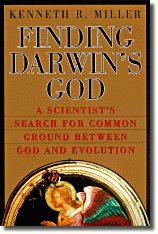"Parts is Parts"
(A description of Hall's
experiments on the evolved beta-galactosidase system. From pp.
145-147 of Finding Darwin's God)
What happens if we step things up to the next level, asking evolutionary mechanisms to "design" a multi-part system, a system that, in Behe's terminology, would be irreducibly complex? The most direct way to do this would be with a true acid test - by using the tools of molecular genetics to wipe out an existing multipart system, and then see if evolution can come to the rescue with a system to replace it.
The "lac" genes of bacteria are just such a system. Lactose is a sugar, similar in many ways to sucrose, ordinary table sugar, that bacteria can use as a food. In order to do this, they first have to produce an enzyme that can cut lactose in half, releasing two simple sugars (glucose and galactose) that the metabolism of the cell can use for energy. Not surprisingly, bacteria are "smart" enough to "know" that there is no point in making this enzyme - known as galactosidase - when there is no lactose in the medium in which they are growing. In the absence of lactose they automatically shut off the genes required to utilize lactose for food. Clever biochemistry. Behe might say, "clever design."
The bacterium pulls this feat off by combining highly sensitive control genes with the "structural" genes that actually specify the amino acids in the galactosidase enzyme. The control gene keeps the enzyme gene switched off except when it is needed to produce enough of the enzyme to metabolize lactose. Could evolution have produced such a lovely two-part system? Barry Hall tested this possibility in 1982 by deleting the structural gene for galactosidase. He then "challenged" cells with the deletion to grow on lactose. At first, of course, they couldn't. Before long, mutant strains appeared that could handle lactose nearly as well as the originals.
How could this be? How could these cells have reconstructed the information from the missing gene in such a short time, using only the random, undirected processes of mutation and natural selection? The answer, of course, is that these bacteria didn't make the new galactosidase enzyme from scratch. They made it by tinkering with another gene, in which a simple mutation changed an existing enzyme just enough to make it also capable of cleaving the bond that holds the two parts of lactose together. Now, you might think that this wouldn't be enough, and you'd be right. Simply re-engineering an existing protein to replace galactosidase would make no difference unless the control region of that gene was also changed to ensure that the gene was expressed when lactose was present. Significantly, when Hall looked at the control regions of the mutant replacement gene, he found that they had been mutated as well - some of them were now switched on all the time, but a few of them responded directly to lactose, switching the gene on and off as needed.
That would have been impressive enough, but Hall's clever germs didn't stop there. When he selected them further to grow on another sugar (lactulose), he obtained a second series of mutants with a new enzyme that accidentally (in a sense) produced allolactose, the very same chemical signal that is normally used to switch on all of the lac genes. This important development meant that now the cells could switch on synthesis of a cell membrane protein, the lac permease, that speeds the entry of lactose into the cell. Summarizing this work, evolutionary biologist Douglas Futumya wrote:
Thus an entire system of lactose utilization had evolved, consisting of changes in enzyme structure enabling hydrolysis of the substrate; alteration of a regulatory gene so that the enzyme can be synthesized in response to the substrate; and the evolution of an enzyme reaction that induces the permease needed for the entry of the substrate. One could not wish for a batter demonstration of the neoDarwinian principle that mutation and natural selection in concert are the source of complex adaptations. [DJ Futumya, Evolution, ©1986, Sinauer Associates, Sunderland, MA. pp. 477-478.]
Think for a moment - if we were to happen upon the interlocking biochemical complexity of the re-evolved lactose system, wouldn't we be impressed with the "intelligence" of its design? Lactose triggers a regulatory sequence that switches on the synthesis of an enzyme that then metabolizes lactose itself. And the products of that successful lactose metabolism then activate the gene for the lac permease, which ensures a steady supply of lactose entering the cell. Irreducible complexity. What good would the permease be without the galactosidase? And what use would either of them be without regulatory genes to switch them on? And what good would lactose- responding regulatory genes be without lactose-specific enzymes? No good, of course. And therefore, by very same logic applied by Michael Behe to other systems, we could conclude that the system had been designed. Except we know that it was not designed. We know it evolved because we watched it happen right in the laboratory!
No doubt about it - the evolution of biochemical systems, even complex multi-part ones, is explicable in terms of evolution. Behe is wrong.
Finding Darwin's God

HarperCollins
New York
Miller's Analysis of those Criticisms.
NOTE: Hall's experiments describing this system appear in two papers: BG Hall (1982) Evolution on a Petri Dish. The evolved b-galactosidase system as a model for studying acquisitive evolution in the laboratory. Evolutionary Biology 15: 85-150. Also: BG Hall (1983) Evolution of new metabolic functions in laboratory organisms, in Evolution of Genes and Proteins, M Nei and RK Koehn (eds.), Sinauer Associates, Sunderland, MA.